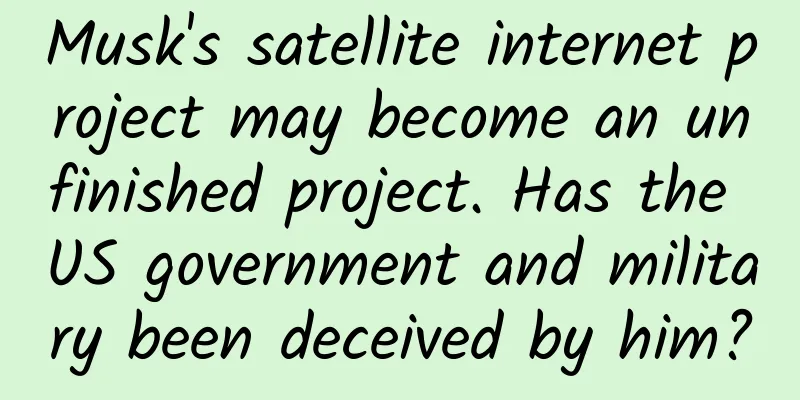Musk's satellite internet project may become an unfinished project. Has the US government and military been deceived by him?

|
Elon Musk, founder of the commercial rocket company SpaceX, first proposed a satellite internet constellation plan called "Starlink" in 2015. According to Musk's idea, Starlink will replace traditional communication facilities on the ground to provide high-speed and stable broadband Internet services to remote areas, and relatively cheap satellite broadband services to urban areas. At the 2020 Satellite Conference in Washington, Musk said that Starlink can provide ultra-low latency network services and is sufficient to support online competitive games, so consumers don't have to worry about the Internet speed not being fast enough. When SpaceX announced the Starlink plan in the early days, it proposed that the network delay would be between 20 and 35 milliseconds. But Musk said at the Satellite Conference, "The network connection experience will be very good, and now our goal is to reduce the delay to less than 20 milliseconds." Once the network delay can be lower than 20 milliseconds, users will be able to play games smoothly through satellite Internet, and in some cases it will even be better than the widely used 4G network. In addition to the advantages of low network latency and ease of use, Musk also pointed out that Starlink does not pose a threat to traditional telecommunications companies. Starlink will be sufficient to provide network services in rural areas, meeting people's needs for watching videos, playing games, etc., and the quality of network connection is guaranteed; but it does not mean that everyone will be a user of Starlink services in the future. In rural or remote areas, the population density is low, and users will be able to get sufficient bandwidth; in urban environments, the situation will be different. At this time, the communication satellites in space are not as good as the network base stations on the ground, and it is difficult to provide users with ultra-high-density network connections; when urban users are too concentrated and use satellite networks at the same time, the bandwidth allocated to each mobile phone or other device is not enough. Therefore, to a certain extent, Starlink is far from posing a threat to telecommunications companies. The commercial application prospects of Starlink are certainly very good, but Musk envisions that the number of Starlink satellites in orbit will reach 12,000, or possibly 42,000. SpaceX wants to send so many satellites into space and complete the Starlink plan. Obviously, it mainly depends on SpaceX's rocket design, manufacturing and launch capabilities. Because Starlink is a commercial project, SpaceX must ensure that the service quality of Starlink can fully meet the needs of the market and reduce the cost of Starlink to the lowest possible level. SpaceX wants to reduce the cost of Starlink to a low enough level, and one of the feasible solutions is to reduce the cost of rockets. There is relatively little room for further reduction in the cost of rockets in the R&D, design and manufacturing links, so reducing the cost of rockets in the launch link and related costs seems to be the only way out. In this regard, the solution given by SpaceX is rocket recovery and reuse. In fact, in the 18 years since the establishment of SpaceX, it has basically been moving in the general direction of rocket recovery and reuse, constantly studying and exploring, continuously launching rockets, constantly summarizing experience and lessons, and then continuously improving and innovating. First, SpaceX's original rocket vertical technology is indeed at the most advanced level in the world. In the future, if humans want to implement precise landings on other planets, they will definitely use vertical take-off and landing, or technologies similar to vertical take-off and landing. Therefore, the vertical take-off and landing pioneered by SpaceX is naturally a major trend in the commercial aerospace field. Second, can the rocket recovery and reuse solution that SpaceX has shown to the world achieve the effect of significantly reducing costs in business? According to the analysis of "space enthusiasts", the process of SpaceX from launching to recovering rockets can be roughly divided into five stages: the ignition and takeoff stage; the active ascent flight stage (after the rocket has flown for about 180 seconds, at an altitude of about 50 miles from the ground, the engine of the first-stage rocket is shut down, and the first and second-stage rockets continue to fly); the inertial flight and attitude adjustment stage (the first-stage rocket continues to fly after the engine is shut down, and when it is about to reach the highest position from the ground, it begins to adjust its attitude so that the tail faces the ground and enters the return state); the re-entry flight stage (when the first-stage rocket is about to enter the dense atmosphere, the engine ignites to decelerate, thereby reducing the impact of aerodynamic heating); the soft landing stage (the grid wings of the first-stage rocket open to adjust the attitude during flight, the engine ignites and throttles, and it softly lands on land or sea platforms). "Space enthusiasts" believe that SpaceX's rocket recovery and reuse solution has at least three "deficiencies". First, the first-stage rocket consumes a certain amount of propellant in the process of returning to the ground, which damages the rocket's carrying capacity. Second, in order to control the first-stage rocket to return to the ground, SpaceX needs to add control and landing equipment to the first-stage rocket, resulting in an increase in the cost of the rocket. Third, after the first-stage rocket returns to the ground and is recovered, SpaceX needs to refurbish and repair the first-stage rocket, and may also need to replace certain parts on the rocket. This is another cost expense. In May 2018, before the Falcon 9 Block 5 carried out its flight mission, Musk said that the first stage of the Falcon 9 accounted for 60% of the total price, the upper stage accounted for 20% of the total price, the fairing accounted for 10% of the total price, and other launch-related expenses accounted for 10%. According to the commercial launch quotation of the Falcon 9 rocket of US$62 million, the recyclable and reusable first stage rocket accounted for US$37.2 million, the upper stage accounted for US$12.4 million, the fairing accounted for US$6.2 million, and other costs accounted for US$6.2 million. The recovery and reuse of the first-stage rocket naturally incurs additional expenses: reinstallation of electronic equipment; expenses related to the landing legs, including hydraulic or electromechanical systems, high-temperature metal structures at the tail end, etc.; recovery logistics costs, including capturing the fairing by ship at sea, landing site maintenance, and transporting the booster to the factory for refurbishment. Assuming that both the first-stage rocket and the fairing are recovered and used for the second rocket launch, the cost of the first-stage rocket is: $37.2 million * 20% = $7.44 million; the cost of the fairing is: $6.2 million * 20% = $1.24 million; the above and other costs remain unchanged, then the second launch quotation can be reduced to $27.28 million at once. According to this ideal calculation, as the number of times the rocket (first stage and fairing) is reused increases, the launch quotation of the Falcon 9 rocket will become lower and lower, and when the rocket can be reused about 10 times in a row, it will break even. By the same token, the launch cost of the Falcon Heavy rocket will continue to decrease as the number of reuses increases. On April 16, 2020, CNBC published an article stating that earlier this year, Christopher Koulouris, director of SpaceX rocket assembly, said, "The cost of launching a rocket is $28 million, and reuse is the reason for the price reduction." On April 3, Tori Bruno, CEO of the United Launch Alliance, tweeted that the United Launch Alliance has carefully modeled the break-even point of reusable rockets and concluded that it takes an average of about 10 flights to break even. In the latest tweet, Bruno said that the United Launch Alliance has been tracking SpaceX's break-even point, and they currently believe that the assessment of 10 flights is still valid. So far, SpaceX's highest record is to reuse a booster 5 times. Therefore, the United Launch Alliance believes that SpaceX has not proven its economic sustainability goals (of reusable rockets). On April 26, GK Launch Services, an international launch service provider under the Russian Space Corporation, published a long article on Facebook, using PPT to prove that SpaceX is actually selling below cost and that it is precisely relying on orders from the US government and military that it can achieve the result of reducing launch costs. GK's reports are based on public information, and the data comes from SpaceX itself. Musk and SpaceX CEO Shotwell have revealed several key data about the Falcon 9 rocket: SpaceX spent $1 billion on reusable research and development; the first stage of the rocket accounted for 70% of the Falcon 9 hardware cost; the second stage and the fairing accounted for 30%, which is not a particularly balanced proportion; the rocket fairing cost $6 million. GK believes that based on the price quotes provided by SpaceX on its official website, the Falcon 9 costs $62 million and the Falcon Heavy costs $90 million. After deducting the launch site, fuel filling and other expenses (accounting for 30-35% of the cost), the hardware price of the Falcon 9 should not exceed $40.3 million. If the first stage accounts for 70% of the hardware cost, the cost of the first stage is $28.2 million, and the cost of the second stage and fairing is $12.1 million. It is known that the fairing is worth $6 million, so the value of the second stage plus the load distributor is $6.1 million in total. This conflicts with what Shotwell said that the proportion of the two is not particularly balanced.
GK took the PACE satellite launch contract signed by SpaceX and NASA on February 5, 2020 as an example. The contract price of the project was $80.4 million. Based on this, the hardware cost of Falcon 9 is $52.3 million. This figure is different from the $40.3 million hardware cost calculated based on the quotation on SpaceX's official website. So, GK asked, what is the hardware cost of Falcon 9? $52.3 million or $40.3 million? GK gave another example. On March 7, 2020, SpaceX signed a $297 million commercial contract with the U.S. Air Force, including two Falcon 9 and one Falcon Heavy launch. According to SpaceX's quotation ratio, the price of Falcon Heavy is 1.5 times that of Falcon 9. According to this, the price of Falcon 9 in this $297 million contract should be $84.9 million (hardware price $55.2 million), and the price of Falcon Heavy in this contract is $127.2 million . GK clearly questioned that if the military contract uses a reusable Falcon 9 rocket, why not pay according to SpaceX's $62 million price? According to the FAA's 2018 annual report, SpaceX's international space station cargo contract before 2024 has a total contract value of $1.6 billion from 2008 to 2017, involving 12 CRS1 cargo missions; a total contract value of $1.2 billion from 2017 to 2018, involving 5 CRS 1E cargo missions; and a total contract value of $900 million from 2019 to 2024, involving 6 CRS 2 cargo missions. The above totals 23 cargo missions with a total contract value of $3.7 billion. It is calculated that NASA pays an average of $160.9 million for each cargo mission. According to the above ratio, the total price of the Falcon rocket plus the Dragon spacecraft is $104.5 million. Further calculations of the price of the Falcon 9 cargo mission to the International Space Station show that when SpaceX uses a completely newly built rocket, the first stage costs $50.1 million, accounting for 48% of the total cost; the second stage costs $14.4 million, accounting for 13.7% of the total cost. GK estimates that the total price of the Dragon spacecraft is $40 million, accounting for 38.3% of the total cost. At this point, GK has basically completed the proof of the first layer of dumping argument: SpaceX's overseas sales prices are lower than the domestic prices in the United States . GK pointed out that SpaceX's quotes to NASA and military users are also different (although the prices are close). And this domestic price is higher than the price of Falcon 9 in the international market. GK then pointed out that after the first stage of the rocket is reusable, the cost of repair and reconstruction work accounts for 30% of the original cost. It is concluded that the cost of the reusable first stage is US$15.03 million. Adding the known cost of the second stage of US$14.4 million, the fairing of US$6 million, and the payload dispenser of US$1 million, the cost of the entire rocket is reduced to US$36.4 million. On March 30, 2017, SpaceX used a reusable first stage for its first commercial launch, launching the SES-10 satellite for the European Communications Satellite Operator. The first stage of this rocket was used on the Dragon spacecraft for the commercial resupply mission to the International Space Station in April 2016. From a commercial perspective, NASA paid the full cost of this rocket because of the Dragon spacecraft mission in 2016, and the first stage was recovered and reused for the SES-10 satellite launch. SpaceX quoted $56 million for the reuse of the first stage, and the actual cost was $36.4 million, accounting for 65% of the launch service quote. At this point, GK has basically completed the proof of the second layer of dumping argument: the U.S. government and military missions pay for SpaceX's reusable rockets, and SpaceX recovers the first stage of the rocket and uses it for foreign launch services, resulting in unfairly low prices. GK Launch Services concluded: Considering that NASA has provided SpaceX with more than $7 billion in funding through the International Space Station cargo contract, it is only possible to conclude that reusable technology is economical if there is an "anchor" customer in the domestic market (NASA and the U.S. Air Force in the case of SpaceX). |
<<: 5G independent networking commercialization will be realized within this year
>>: Three considerations to spark innovation on the modern web
Recommend
"2021 Bots Automation Threat Report" in-depth analysis of the four characteristics and five scenarios of automation threats
As Bots automation tools become more platform-bas...
How much do you know about the legendary network speed limit?
1. Recently, many people have said that the unlim...
DMIT's new San Jose data center starts at $36.9/year, 15% off + free data
DMIT.io opened a new data center in San Jose, USA...
How to solve the packet loss problem in TCP transmission protocol
1. Before answering this question, we need to con...
spinservers: US high bandwidth servers starting from $89/month, San Jose/Dallas data centers, 10Gbps bandwidth
spinservers recently released a new promotion pla...
H3C ranks first! Its market share of Chinese enterprise network switches exceeds 30% in the first three quarters of 2022
Recently, IDC released the "China Ethernet S...
New challenges for operation and maintenance in 2018: Three experts tell you how to achieve intelligent operation and maintenance
[51CTO.com original article] With the trend of cl...
An article to help you understand the concept of TCP/IP
1. What is TCP/IP? Transmission Control Protocol/...
How to Re-evaluate Unified Communications Tools in the Work-from-Home Era
As the pandemic shapes a new normal, value chains...
Machine Learning in Blockchain Technology
Modernity brought new and groundbreaking things t...
Understanding the working principle of keepalive in one article
Keepalive is a high-availability component that i...
HostYun launches new Hong Kong U.2 SSD series VPS, 200Mbps bandwidth VPS monthly payment starts from 18 yuan
In addition to the new computer room, HostYun als...
Should you upgrade your 5G package? Read this article before deciding
Recently, I often receive such calls on my two mo...
Huawei's Shi Yaohong: The new infrastructure focuses on "foundation" to enable intelligent upgrades in thousands of industries
New infrastructure (i.e. new infrastructure const...









